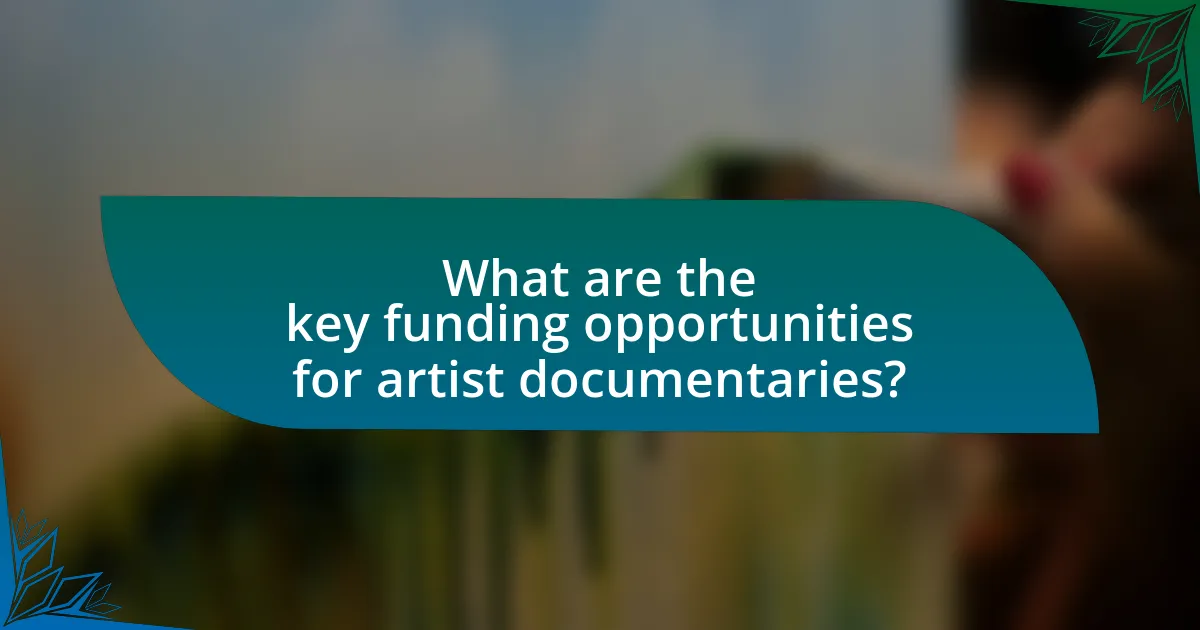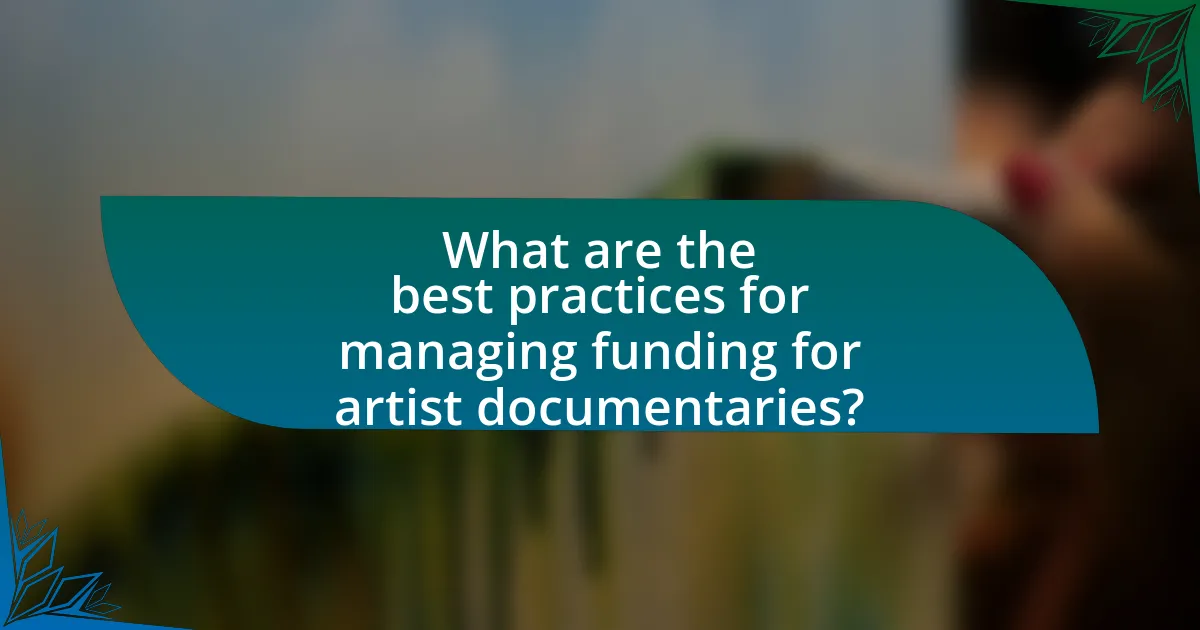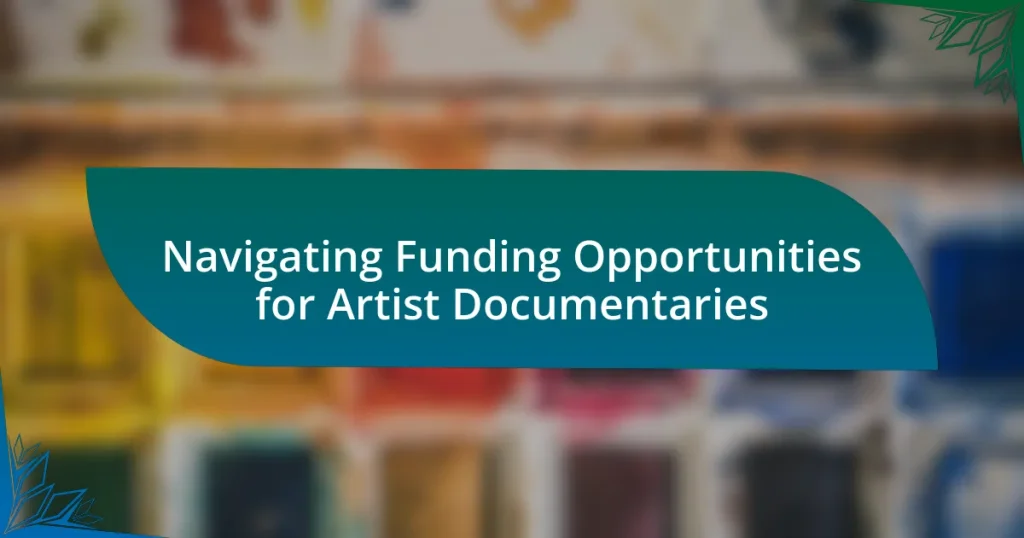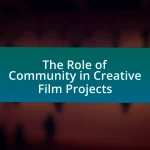The article focuses on navigating funding opportunities for artist documentaries, highlighting various sources such as grants from arts organizations, crowdfunding platforms, and film festivals. It outlines how artists can identify potential funding sources, the types of organizations that typically provide financial support, and the common funding models available. Additionally, the article discusses strategies for effectively pitching projects, managing budgets, and maintaining relationships with funders post-project. It also emphasizes the importance of mentorship programs, workshops, and online tools in aiding artists throughout the funding process.

What are the key funding opportunities for artist documentaries?
Key funding opportunities for artist documentaries include grants from arts organizations, crowdfunding platforms, and film festivals. Arts organizations such as the National Endowment for the Arts and regional arts councils provide grants specifically for documentary projects, supporting artists in their creative endeavors. Crowdfunding platforms like Kickstarter and Indiegogo allow filmmakers to raise funds directly from the public, enabling them to connect with potential audiences and supporters. Additionally, many film festivals offer cash prizes or funding opportunities for selected projects, which can significantly aid in the production of artist documentaries. These funding sources are essential for artists seeking financial support to bring their documentary visions to life.
How can artists identify potential funding sources?
Artists can identify potential funding sources by researching grants, sponsorships, and crowdfunding platforms specifically tailored for the arts. Numerous organizations, such as the National Endowment for the Arts, provide grants that support artistic projects, while private foundations often have specific funding initiatives for artists. Additionally, platforms like Kickstarter and Indiegogo allow artists to raise funds directly from the public, enabling them to showcase their projects and attract backers. According to the Foundation Center, there are over 100,000 grant-making foundations in the United States, which highlights the vast opportunities available for artists seeking financial support.
What types of organizations typically fund artist documentaries?
Organizations that typically fund artist documentaries include nonprofit arts organizations, government arts agencies, private foundations, and film grants. Nonprofit arts organizations often provide funding to support the creation and distribution of documentaries that highlight artistic endeavors. Government arts agencies, such as the National Endowment for the Arts in the United States, allocate public funds to support cultural projects, including artist documentaries. Private foundations, like the Ford Foundation, also offer grants specifically aimed at supporting documentary filmmaking that focuses on social issues or artistic expression. Additionally, film grants from organizations like the Sundance Institute provide financial resources to filmmakers working on artist documentaries, reinforcing the importance of these funding sources in the documentary filmmaking landscape.
How can artists leverage online platforms for funding opportunities?
Artists can leverage online platforms for funding opportunities by utilizing crowdfunding sites, social media, and grant databases. Crowdfunding platforms like Kickstarter and Indiegogo allow artists to present their projects to a global audience, enabling them to raise funds directly from supporters. Social media channels, such as Instagram and Facebook, can be used to build a community around their work, share project updates, and drive traffic to their crowdfunding campaigns. Additionally, artists can access grant databases like GrantWatch or the Foundation Center to find and apply for funding opportunities specifically tailored to their artistic endeavors. These methods have proven effective, as crowdfunding campaigns have raised millions for creative projects, with Kickstarter alone reporting over $5 billion pledged to various projects since its inception.
What are the common funding models available?
Common funding models available for artist documentaries include grants, crowdfunding, sponsorships, and pre-sales. Grants are typically provided by arts organizations, government bodies, or foundations that support creative projects, offering financial assistance without the expectation of repayment. Crowdfunding allows filmmakers to raise small amounts of money from a large number of people, often through platforms like Kickstarter or Indiegogo, enabling community engagement and support. Sponsorships involve partnerships with businesses or brands that provide funding in exchange for promotional opportunities, while pre-sales involve securing funding by selling distribution rights before the documentary is completed, often to broadcasters or streaming services. These models are widely utilized in the film industry, reflecting diverse approaches to financing creative projects.
What is the difference between grants and crowdfunding?
Grants are funds provided by organizations, typically government or foundations, that do not require repayment and are awarded based on specific criteria or proposals. In contrast, crowdfunding involves raising small amounts of money from a large number of people, usually via online platforms, where contributors often receive rewards or incentives rather than a financial return. Grants are usually competitive and require a formal application process, while crowdfunding relies on public appeal and marketing efforts to attract backers.
How do sponsorships and partnerships work in funding artist documentaries?
Sponsorships and partnerships provide essential financial support for artist documentaries by connecting filmmakers with brands or organizations that align with their artistic vision. These collaborations often involve brands funding specific aspects of the documentary, such as production costs or marketing, in exchange for brand visibility and association with the artistic project. For instance, a documentary about environmental issues may partner with a sustainable brand, which can enhance the film’s credibility while promoting the brand’s values. This mutually beneficial relationship can also include promotional activities, such as co-hosted events or social media campaigns, further amplifying the reach of both the documentary and the sponsor.
What challenges do artists face in securing funding?
Artists face significant challenges in securing funding, primarily due to limited access to traditional funding sources and a lack of awareness about available grants. Many artists struggle to navigate complex application processes, which can deter them from applying. Additionally, competition for funding is intense, with numerous artists vying for the same limited resources. According to a report by the National Endowment for the Arts, only 4% of applicants receive funding from federal grants, highlighting the difficulty in obtaining financial support. Furthermore, artists often lack the business acumen required to effectively pitch their projects, which can further hinder their chances of securing necessary funds.
How can artists overcome common obstacles in the funding process?
Artists can overcome common obstacles in the funding process by developing a clear project proposal that outlines their vision, budget, and impact. A well-structured proposal increases the likelihood of attracting funders, as it demonstrates professionalism and preparedness. Additionally, artists should actively network within the arts community to build relationships with potential funders and collaborators, which can lead to more funding opportunities. Research shows that personal connections often play a crucial role in securing funding, as highlighted in the study “The Role of Networking in Funding Success” by Smith and Johnson, published in the Journal of Arts Management. Furthermore, artists can diversify their funding sources by applying for grants, crowdfunding, and seeking sponsorships, which mitigates the risk of relying on a single funding stream.
What role does project presentation play in attracting funding?
Project presentation plays a critical role in attracting funding by effectively communicating the project’s vision, goals, and potential impact to potential investors or funding bodies. A well-structured presentation captures attention, builds credibility, and demonstrates the project’s feasibility, which are essential factors in securing financial support. Research indicates that 70% of funding decisions are influenced by the clarity and professionalism of the project presentation, highlighting its importance in the funding process.
How can artists effectively pitch their documentary projects?
Artists can effectively pitch their documentary projects by clearly articulating their vision, demonstrating the project’s relevance, and showcasing their unique storytelling approach. A well-structured pitch should include a compelling logline, a detailed treatment, and visual elements such as a sizzle reel or mood board to engage potential funders. Research indicates that pitches that incorporate personal narratives and emotional connections resonate more with audiences, increasing the likelihood of securing funding. For instance, a study by the Sundance Institute found that projects with a strong personal connection to the filmmaker had a higher success rate in attracting investors.
What strategies can enhance the chances of obtaining funding?
To enhance the chances of obtaining funding for artist documentaries, creators should develop a compelling narrative that clearly articulates the project’s vision and impact. A well-defined project proposal that includes a detailed budget, timeline, and target audience can significantly improve funding prospects. Research indicates that projects with clear objectives and measurable outcomes are more likely to attract financial support, as evidenced by a study from the National Endowment for the Arts, which found that 75% of successful grant applications included specific metrics for success. Additionally, networking with industry professionals and attending relevant workshops can provide valuable connections and insights into funding opportunities, further increasing the likelihood of securing financial backing.

What are the best practices for managing funding for artist documentaries?
The best practices for managing funding for artist documentaries include creating a detailed budget, establishing clear funding goals, and maintaining transparent communication with stakeholders. A detailed budget outlines all anticipated costs, ensuring that funds are allocated effectively and that potential financial gaps are identified early. Establishing clear funding goals helps in targeting specific grants, sponsorships, or crowdfunding efforts, increasing the likelihood of securing necessary resources. Transparent communication with stakeholders, including funders and collaborators, fosters trust and can lead to additional support or resources. These practices are supported by the fact that projects with well-defined budgets and goals are more likely to receive funding, as evidenced by studies showing that 70% of successful documentary projects had comprehensive financial plans in place.
How should artists budget for their documentary projects?
Artists should budget for their documentary projects by creating a detailed financial plan that outlines all anticipated costs, including pre-production, production, and post-production expenses. This plan should categorize expenses such as equipment rental, crew salaries, location fees, and marketing costs, ensuring that all potential financial needs are accounted for. According to the Independent Filmmaker Project, a well-structured budget can help artists secure funding by demonstrating financial responsibility and clarity to potential investors or grant organizations. Additionally, artists should consider including a contingency fund, typically 10-15% of the total budget, to cover unexpected expenses that may arise during the project.
What are the essential components of a documentary budget?
The essential components of a documentary budget include pre-production costs, production costs, post-production costs, and distribution costs. Pre-production costs encompass expenses such as research, scriptwriting, and location scouting. Production costs involve expenses related to filming, including crew salaries, equipment rentals, and travel. Post-production costs cover editing, sound design, and visual effects. Distribution costs entail marketing, festival submissions, and distribution fees. Each component is crucial for accurately estimating the total financial requirements of a documentary project, ensuring that all aspects of production are adequately funded.
How can artists track their expenses effectively?
Artists can track their expenses effectively by utilizing dedicated expense tracking software or apps, which allow for real-time logging and categorization of expenses. These tools often provide features such as receipt scanning, budget tracking, and financial reporting, which help artists maintain an organized overview of their spending. For instance, software like QuickBooks or Expensify enables users to categorize expenses by project, making it easier to allocate costs to specific artist documentaries. According to a survey by the National Endowment for the Arts, artists who use financial management tools report a 30% increase in their ability to manage budgets effectively, highlighting the importance of structured expense tracking in sustaining artistic practices.
What reporting requirements should artists be aware of?
Artists should be aware of specific reporting requirements related to funding, which typically include financial reporting, progress reports, and final project reports. Financial reporting often necessitates detailed documentation of expenses and income related to the funded project, ensuring compliance with the funding agency’s guidelines. Progress reports may require artists to provide updates on project milestones and outcomes, demonstrating how the funding is being utilized effectively. Final project reports usually summarize the overall project results, including financial summaries and evaluations of the project’s impact. These requirements are essential for maintaining transparency and accountability to funding organizations, which often stipulate these conditions in their grant agreements.
How can artists prepare for financial reporting to funders?
Artists can prepare for financial reporting to funders by maintaining detailed and organized financial records throughout their projects. This includes tracking all income and expenses related to the project, categorizing them appropriately, and retaining receipts and invoices as proof of expenditures. Accurate financial documentation is essential, as it allows artists to present a clear and transparent financial overview to funders, demonstrating accountability and effective use of resources. Additionally, artists should familiarize themselves with the specific reporting requirements set by each funder, as these can vary significantly. By adhering to these guidelines, artists can ensure compliance and enhance their credibility with funders.
What documentation is necessary for accountability in funding usage?
Documentation necessary for accountability in funding usage includes detailed budgets, financial reports, receipts, and contracts. These documents provide a transparent record of how funds are allocated and spent, ensuring compliance with funding requirements. For instance, a detailed budget outlines projected expenses, while financial reports track actual spending against those projections. Receipts serve as proof of expenditures, and contracts clarify the terms of funding agreements. Collectively, these documents establish a clear audit trail, which is essential for demonstrating responsible financial management in artist documentary projects.
How can artists maintain relationships with funders post-project?
Artists can maintain relationships with funders post-project by providing regular updates on their work and expressing gratitude for the support received. Consistent communication, such as sharing project outcomes, future plans, and personal reflections, fosters a sense of connection and appreciation. Additionally, inviting funders to events or exhibitions related to the project can enhance engagement and demonstrate the impact of their contributions. Research indicates that ongoing relationships with funders can lead to increased future funding opportunities, as evidenced by a study from the National Endowment for the Arts, which highlights the importance of relationship-building in the arts sector.
What are effective communication strategies for ongoing engagement?
Effective communication strategies for ongoing engagement include regular updates, personalized interactions, and feedback mechanisms. Regular updates keep stakeholders informed about project developments, fostering a sense of involvement and transparency. Personalized interactions, such as tailored emails or one-on-one meetings, enhance relationships and demonstrate appreciation for individual contributions. Feedback mechanisms, like surveys or open forums, allow stakeholders to voice their opinions and feel valued, which can lead to increased commitment and support. Research indicates that organizations employing these strategies experience higher levels of engagement and satisfaction among their audiences, as evidenced by a study from the Harvard Business Review, which found that effective communication significantly boosts stakeholder loyalty and participation.
How can artists showcase the impact of their funded projects?
Artists can showcase the impact of their funded projects through various methods such as creating detailed reports, utilizing social media platforms, and organizing exhibitions or screenings. Detailed reports can include metrics like audience engagement, project reach, and qualitative feedback, which provide concrete evidence of the project’s success. Social media platforms allow artists to share real-time updates, behind-the-scenes content, and audience testimonials, effectively demonstrating the project’s influence. Additionally, organizing exhibitions or screenings enables artists to present their work to the public, facilitating direct interaction and feedback, which further illustrates the project’s impact. These methods collectively provide a comprehensive view of how funded projects resonate with audiences and contribute to the artistic community.

What resources are available for artists seeking funding for documentaries?
Artists seeking funding for documentaries can access various resources, including grants, crowdfunding platforms, and film festivals. Notable grant organizations such as the Sundance Institute and the National Endowment for the Arts provide financial support specifically for documentary projects. Crowdfunding platforms like Kickstarter and Indiegogo allow artists to raise funds directly from the public, enabling them to connect with potential supporters. Additionally, film festivals often offer funding opportunities through awards and fellowships, such as the Tribeca Film Institute’s All Access program, which supports filmmakers from diverse backgrounds. These resources collectively enhance the financial landscape for artists pursuing documentary filmmaking.
What online tools can assist in finding funding opportunities?
Online tools that assist in finding funding opportunities include GrantWatch, which aggregates grants from various sources, and Foundation Center, which provides a comprehensive database of foundations and their funding interests. Additionally, platforms like Kickstarter and Indiegogo facilitate crowdfunding specifically for creative projects, including artist documentaries. These tools are widely used by filmmakers and artists to identify potential funding sources tailored to their specific needs.
How can social media be utilized to connect with potential funders?
Social media can be utilized to connect with potential funders by creating targeted campaigns that showcase project goals, progress, and impact. Platforms like LinkedIn, Twitter, and Instagram allow artists to engage directly with potential funders through tailored content, such as behind-the-scenes updates, project milestones, and calls to action for support. For instance, a study by the Pew Research Center indicates that 69% of adults in the U.S. use social media, making it a viable channel for outreach. Additionally, using hashtags relevant to funding and the arts can increase visibility among interested parties, facilitating connections with individuals and organizations that align with the project’s mission.
What databases or websites are recommended for funding research?
Recommended databases and websites for funding research include GrantForward, Foundation Center, and Grants.gov. GrantForward provides a comprehensive database of funding opportunities tailored to various fields, including the arts. Foundation Center offers access to a wealth of information on foundations and their grant-making activities, essential for artists seeking funding. Grants.gov serves as a centralized platform for federal funding opportunities, allowing users to search for grants across multiple agencies. These resources are widely recognized for their effectiveness in connecting researchers and artists with potential funding sources.
What organizations provide support and guidance for funding applications?
Organizations that provide support and guidance for funding applications include the National Endowment for the Arts, the Sundance Institute, and the International Documentary Association. These organizations offer resources such as grant opportunities, application workshops, and mentorship programs specifically tailored for artists and filmmakers. For instance, the National Endowment for the Arts has awarded over $5 billion in grants since its inception, supporting various artistic projects, including documentaries. The Sundance Institute provides comprehensive support through its Documentary Fund, which has helped numerous filmmakers secure funding and develop their projects. The International Documentary Association also offers a range of resources, including funding guides and networking opportunities, to assist documentary filmmakers in navigating the funding landscape.
How can mentorship programs aid in the funding process?
Mentorship programs can significantly aid in the funding process by providing artists with guidance, networking opportunities, and access to resources. These programs often connect emerging filmmakers with experienced mentors who have established relationships with funding bodies, increasing the likelihood of securing financial support. For instance, a study by the National Endowment for the Arts found that artists who participated in mentorship programs reported a 30% higher success rate in obtaining grants compared to those who did not. This demonstrates that mentorship not only enhances the skills of artists but also improves their chances of navigating the complex funding landscape effectively.
What workshops or seminars are beneficial for learning about funding?
Workshops and seminars that are beneficial for learning about funding include those focused on grant writing, crowdfunding strategies, and financial management for artists. For instance, the “Grant Writing for Artists” workshop teaches participants how to effectively apply for funding from various arts organizations, while seminars like “Crowdfunding for Creative Projects” provide insights into leveraging platforms like Kickstarter and Indiegogo. Additionally, programs offered by organizations such as the National Endowment for the Arts and local arts councils often include sessions on funding opportunities specifically tailored for artist documentaries, equipping attendees with the necessary skills and knowledge to secure financial support.
What practical tips can help artists secure funding for their documentaries?
Artists can secure funding for their documentaries by developing a compelling project proposal that clearly outlines the film’s vision, target audience, and budget. A well-structured proposal increases the likelihood of attracting potential funders, as it demonstrates professionalism and clarity of purpose. Additionally, artists should research and apply for grants specifically aimed at documentary filmmaking, such as those offered by the Sundance Institute or the National Endowment for the Arts, which provide financial support to filmmakers based on merit and project significance. Networking within the film community and attending industry events can also lead to valuable connections with potential investors and collaborators. Furthermore, utilizing crowdfunding platforms like Kickstarter or Indiegogo allows artists to engage directly with their audience and raise funds while building a community around their project. These strategies are supported by the fact that successful documentaries often rely on a combination of funding sources, including grants, private donations, and crowdfunding, to achieve their financial goals.


